Text
Knowledge ls POWER! One of The Best Explanation For The Reason Behind The Holocaust
0 notes
Text
0 notes
Text
The Perks of Walking a Mile a Day, According to Experts! One Foot in Front of the Other.
— By Korin Miller | Published: April 30, 2024

Jump To:
How long does it take to walk a mile a day?
Potential benefits of walking a mile a day
Does walking a mile a day burn calories?
Does walking a mile a day boost weight loss?
How to incorporate walking a mile a day into your daily routine
Setting healthy goals, like walking a mile a day, can help to increase your fitness level and keep you moving. And that can also serve as a foundation for bigger fitness gains in the future!
Walking a mile a day can be a smart benchmark for movement. But, this is most powerful for your health when you can do it consistently, says Tony Gentilcore, C.S.C.S., co-owner of Core Collective located in Brookline, MA. “One day where you walk a mile doesn’t seem like much, but over the course of a week, month, year...that all adds up,” he says. “There’s a lot of empowerment and motivation that can be drawn from that.”
Interested in adding walking a mile a day to your to-do list? Here’s what experts recommend you keep in mind, plus how to achieve your goal.
How Long Does It Take to Walk a Mile a Day?
Everyone is different, and the time it takes for you to walk a mile a day can vary wildly from what it will take someone else. “Walking a mile a day can vary in duration depending on individual pace, terrain, and level of fitness,” says Marcel Dinkins, Peloton tread instructor and motivational speaker.
Still, she says that it usually takes about 15 to 20 minutes to walk a mile at a moderate pace.
NSCA-certified trainer Alfonso Moretti recommends aiming for a 20-minute mile when you walk. “That equates to walking 3 miles per hour,” he says.
Potential Benefits of Walking a Mile a Day
There are a lot of perks of walking a mile a day. If you need added motivation, experts recommend keeping these in mind:
It can improve your cardiovascular health. Movement, especially when you can do it at a brisk pace, causes your heart to beat faster and supports good cardiovascular health, Dinkins says.
It’s been linked to a longer life. “Walking has been shown to decrease all-cause mortality,” Moretti says. “In fact, the more you walk, the less likely you’ll be to get cancer, arthritis, heart disease, and much more.”
It can support good mental health. Walking, along with other forms of exercise, can help clear your mind, Dinkins points out.
Does Walking a Mile a Day Burn Calories?
Yes, walking a mile a day burns calories. “Any movement burns calories, and done consistently adds up to a significant positive impact on your weight,” says Beth Warren, R.D.N., founder of Beth Warren Nutrition and author of Living a Real Life With Real Food.
The exact number of calories you’ll burn when you walk a mile depends on a lot of factors, including your personal metabolism, weight, and speed. However, most people will burn around 100 calories, give or take, when they walk a mile.
Does Walking a Mile a Day Boost Weight Loss?
The impact of walking a mile a day on your weight largely depends on what you were doing before. “It stands to reason that if someone goes from doing nothing to walking a mile a day, they may see a trend of weight loss over the course of several weeks to months,” Gentilcore says.
What else you’re doing matters, too, Moretti says. “Walking a mile every day will help boost weight loss if you’re consuming a nutritious diet and are in a calorie deficit,” he says. “You’ll lose weight if you’re consistently burning more calories than you’re consuming.”
How To Incorporate Walking a Mile a Day Into Your Daily Routine
It’s one thing to say you want to walk a mile a day, and another to actually do it. But Dinkin says it can be “quite simple” if you plan for it. “You could walk to work if it’s feasible, take a brisk stroll during your lunch break, make it a post-dinner ritual, or do it the first thing in the morning,” she says.
Gentilcore suggests making an activity calendar to put on your fridge. “There’s a lot of power that comes with checking off that you did something on any given day,” he says. “I find that once someone can see that they’re being consistent, that’s a behavior that will generally stick around for a while.”
Moretti also recommends walking five minutes away from where you are and back five to six days a week from your home or during a break at work. “Every two weeks, add another two minutes to your schedule. After a few months you’ll be walking 20 to 30 minutes per day,” he says.
If walking a mile a day at once seems too intimidating, Dinkins recommends breaking it into smaller segments throughout your day, like parking farther away from your destination and taking the stairs instead of the elevator. “The key is finding what works best for your schedule and lifestyle, and making it a consistent habit,” she says.
Expert Tips to Picking the Right Walking Shoes
While it’s true that walking is a low-impact activity compared with running, it’s still a force-producing, repetitive movement. “Most people don’t think about the ground-reaction force of walking. When you walk, the amount of force through your body is one and a half to two times your body weight per step,” explains Jason Stella, NASM, PES, CES, Life Time national education manager.
Footwear matters. “I like a running shoe for walking because it’s meant to take on three to five times your body weight. It gives you a nice cushion to minimize the force through your body,” he says.
“I like a running shoe for walking because it’s meant to take on three to five times your body weight. It gives you a nice cushion to minimize the force through your body.”
For someone who may overpronate, physical therapist Jessica McManus, PT, FAAOMPT, recommends a motion-control shoe. If you have more-rigid feet and high arches, she suggests a softer, more flexible shoe. You also want to make sure you can spread your toes and wiggle them in the toe box.
She encourages walkers to shop in the running-shoe section of the store, where the most-cushioned shoes can be found. Your local running store can help you determine the most appropriate shoe for your foot.
What about barefoot or minimalist shoes? McManus says there is a place for them. “If you’re intrigued by the idea of making your feet stronger, I recommend a gradual progression to zero-drop shoes with a wide toe box,” she says. “They allow you to use your intrinsic foot muscles and get the support from within. There just needs to be a slower, strategic shift to wearing these shoes. Most athletic shoes have a 5- to 7-millimeter heel drop, so switching to zero drop can open you up to overuse injuries if you jump into them too quickly.”
If you’re interested in moving to barefoot or minimalist shoes, McManus recommends working with a healthcare provider who understands foot mechanics. “One step you can make right away is spending more time barefoot, as long as this is comfortable for you,” she says.
Three Tips to Make the Most of Your Walk:
Though it’s a natural movement, walking is not a simple one. It’s a full-body action that integrates hundreds of muscles and movement at the hips, knees, ankles, shoulders, arms, and torso. All these moving parts make for variation in gait patterns and differences in how you feel during and after a walk. Try these tips for making the most of your walking — and for staying injury-free.
Prewalk
“Before you go for a walk, you’re looking to prepare your body for what you’re about to do,” says physical therapist Jessica McManus, PT, FAAOMPT. She recommends doing some type of dynamic mobility exercise for both the upper and lower body. Marching in place, leg and arm swings, butt kicks, and squats are all great options, or you can start your walk at a slower pace and gradually increase the tempo as your body gets used to the movement.
Jason Stella, NASM, PES, CES, Life Time national education manager, recommends using a lacrosse or massage ball to roll out the arches of your feet. “This helps mobilize the fascia, so your foot is ready to absorb the force of every step.”
Walk
Walk with an upright posture. “Imagine a string pulling from the top center of your head, straight up toward the sky, making you as tall as possible, while you maintain your gaze straight ahead,” says McManus.
Let your arms swing to open your chest. “Think of your sternum as a headlight that gets movement from side to side. This allows you rotation and extension through your midback and thoracic spine,” she explains.
Instead of focusing on reaching one foot out in front of the other, which can lead to overstriding, she suggests you focus on hip extension of your push-off leg. “Imagine you are on a moving walkway, as if you are pushing the belt away behind you as you walk.”
Visualize pushing off through the center of the bottom of your big toe. This keeps your foot in a neutral position and activates the gluteus maximus and the posterior chain muscles of your leg.
Post Walk
“After you walk, you have the benefit of being able to get the most out of sustained-hold stretching, now that your muscles are warm,” says McManus. Focus on static stretches for your calves, hip flexors, quads, and hamstrings, holding each for 30 seconds or more (or try these stretches to help your hip mobility).
1) Walking keeps your body balanced.
2) Walking supports mental health.
3) Walking strengthens your heart and lungs.
4) Walking boosts your metabolism.
5) Walking aids digestion.
6) Walking enhances healthy aging.
— Korin Miller is a freelance writer specializing in general wellness, sexual health and relationships, and lifestyle trends, with work appearing in Men’s Health, Women’s Health, Self, Glamour, and more. She has a master’s degree from American University, lives by the beach, and hopes to own a teacup pig and taco truck one day.
#Fitness#Fitness Tips#Walking#Walking a Mile | Everyday#Burn Calories | Boost Weight Loss#Daily Routine#Perks of Walking#Experts
0 notes
Text
Boak Bollocks and The Scrotums Lickers of The Zionist 🐖 🐷 🐖 🐗 Republi(cunt) US Senators Sent Threatening Letter To International Criminal Court (ICC) Prosecutor Over Possible Netanyahu Arrest Warrant
— Elisabeth Driscoll | U. Bristol Law School, GB | May 6, 2024

A group of 12 Republican US senators sent a letter to International Criminal Court (ICC) Chief Prosecutor Karim Khan on April 24 threatening repercussions if the court issued arrest warrants against Israeli Prime Minister Benjamin Netanyahu and other officials, according to a report by news organization Zeteo, which published the letter Monday.
The senators alleged that the ICC seeks to punish “legitimate actions of self-defense,” citing Khan’s report of the “calculated cruelty” he witnessed following the October 7 attack and making clear that they find “no moral equivalence between Hamas’s terrorism and Israel’s justified response.” They claimed that the arrest warrants “would align the ICC with the largest state sponsor of terrorism.”
The signatories declared they would take any warrant issued as “not only a threat to Israel’s sovereignty but to the sovereignty of the United States.” They threaten, “Target Israel and we will target you” and that any further action will “end all American support for the ICC” and “bar [Khan] and [his] families from the United States.” The letter ended: “You have been warned.”

The Letter Was Signed By Senate Minority Leader Mitch McConnell of Kentucky As Well As Senators Tom Cotton of Arkansas; Marsha Blackburn of Tennessee; Katie Boyd Britt of Alabama; Ted Budd of North Carolina; Kevin Cramer of North Dakota; Ted Cruz of Texas; Bill Hagerty of Tennessee; Pete Ricketts of Nebraska; Marco Rubio and Rick Scott of Florida; and Tim Scott of South Carolina.
A statement from the ICC Prosecutor’s Office issued Friday noted that there was “significant public interest” surrounding present cases and encouraged dialogue, but warned against individuals threatening to retaliate against any actions of the court, which is prohibited under Article 70 of the Rome Statute.
The US is not a party to the Rome Statute and does not recognize ICC jurisdiction over the Palestinian territories, which the court asserts it has. The letter also highlighted the American Service-Members’ Protection Act, which prohibits federal, state and local governments from assisting the ICC and authorizes the US President “to use all means necessary and appropriate to bring about the release” of any “US person” or ally detained by the ICC.
'Target The War Criminal, Fascist, Liar, Conspirator, Apartheid, The Illegal Regime of The Zionist 🐖 🐷 🐖 🐗 Isra-hell and We Will Target You,' Boak Bollocks and The Scrotums Licker of The Zionist Cunts Republi(cunts) Write To ICC Prosecutor Karim Khan in What a Democratic Lawmaker Calls 'Thuggery'
In response to the letter’s release, Canadian Permanent Representative to the United Nations Bob Rae asserted that, “The ICC must be able to do its work free of intimidation.” Senator Cotton’s office confirmed the letter’s authenticity to JURIST in a separate communication on Monday.
The ICC can prosecute individuals for alleged war crimes, crimes against humanity and genocide. Currently, Israel is facing genocide accusations brought by South Africa in the separate International Court of Justice (ICJ), which has imposed provisional measures in Israel’s Gaza offensive.
#Letter | International Criminal Court (ICC) | Prosecutor#Arrest Warrant | War Criminal | Zionist Cunt Satan-Yahu#Boak Bollocks | The Scrotums Lickers of The Zionist 🐖 🐷 🐖 🐗 | Republi(Cunts) US Senators#The War Criminal | Fascist | Liar | Conspirator | Apartheid | The Illegal Regime of The Zionist 🐖 🐷 🐖 🐗 Isra-hell
0 notes
Text
Trapped
— Liu Rui | May 09, 2024

Illustration: Liu Rui/Global Times
Hindering Progress
— Liu Rui | May 05, 2024

Illustration: Liu Rui/Global Times
0 notes
Text
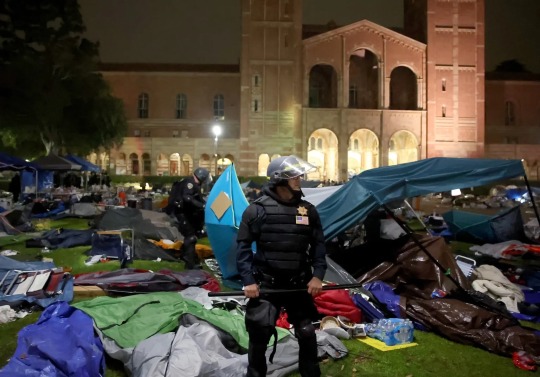
Police tear down tents on UCLA’s Campus, Los Angeles, CA, on May 2, 2024. Photo: Jason Armond/Los Angeles Times via Getty
They Used to Say Arabs Can’t Have Democracy Because It’d Be Bad For “The Terrorist, Fascist, Apartheid, War Criminal, Liar, Conspirator, The Illegal Regime of The Zionist 🐖 🐷 🐖 🐗 Isra-hell.” Now “The War Criminal, Complicit in Genocide in Gaza, The U.S. Can’t Have It Either.”
On Campus, Inside the Capitol, and in Court, There’s an All-out Assault on American Democracy in the Name of “The Terrorist, Fascist, Apartheid, War Criminal, Liar, Conspirator, The Illegal Regime of The Zionist 🐖 🐷 🐖 🐗 Isra-hell.”.
— Murtaza Hussain | May 8 2024 | The Intercept
There’s An Adage among observers of American Middle East policy that suggests the Arab world can’t have democracy because it would be bad for Israel. Arab publics favor the Palestinians, the thinking goes, and will vote in governments that act accordingly — and that is a no-go zone.
Now, with discontent in the U.S. boiling over amid Israel’s war on the Gaza Strip, the framing might need a small update: The U.S., it seems, can’t have democracy either, lest an American democracy end its support for everything and anything Israel wants to do to the Palestinians.
Recent weeks saw violent crackdowns on protests, the passage of bills severely curtailing American free speech rights, and lawsuits seeking to effectively outlaw student groups hostile to Israel.
A serious red line has been crossed: America’s democratic freedoms, expansive on paper, will simply not tolerate serious dissent on the U.S.–Israel relationship. As criticisms of Israel have become more mainstream, the attempt to shut them down entirely has become more extreme.
“Pro-The Terrorist, Fascist, Apartheid, War Criminal, Liar, Conspirator, The Illegal Regime of The Zionist 🐖 🐷 🐖 🐗 Isra-hell Forces” in the U.S. are attacking our own democratic freedoms in order to suppress public outcry about apartheid and potential genocide 6,000 miles away.
In pursuit of this blank-check relationship with an Israeli government that is becoming ever-more intransigent with each passing year, pro-Israel forces in the U.S. are attacking our own democratic freedoms in order to suppress public outcry about apartheid and potential genocide 6,000 miles away. And, if the recent campus crackdowns are any indication, these forces are winning their battle.
With tens of thousands of Palestinians left dead and the Israeli assault on Gaza ongoing, the U.S. protests targeting university ties with Israel over the last month — voluble and outspoken — have been overwhelmingly nonviolent.
Yet these nonviolent protests have met with the full brutal force of the U.S. security state. Dispersing the protest encampments, police have viciously beaten protesters, fired rubber bullets, and enveloped students in dense clouds of tear gas.
Much of the focus has been on the crackdown in New York City, where Columbia University students established the first major encampment the day its president testified at a House antisemitism hearing — but these incredible scenes of police attacking students have played out across the country. By recent count, over 2,300 people have been arrested on campuses in the U.S. since April 18.
It’s not the Middle East, but it is the same anti-democratic suppression of dissent. And one could be forgiven for noting that the crackdown sometimes resembles the suppression in dictatorships like Egypt, Jordan, and Bahrain.
In one stateside case, the squashing of a campus protest even involved what could be called “baltagiya”: the signature Egyptian tactic where unofficial state-aligned militias armed with clubs attack demonstrators before the police swoop in.
This wasn’t, however, Cairo in 2011. It was Los Angeles. At the University of California, Los Angeles, a pro-Israel mob videotaped itself descending on a protest camp and brutally beating protesters, including journalists.
The violence at the UCLA raged on for three hours before police intervened to restore order. Roughly two dozen people were reportedly hospitalized for injuries. It is not clear whether the gangs that attacked the encampment were students of the school.
The following day, police came to tear down the protest camp, firing rubber bullets and arresting some of the same demonstrators who had been attacked by thugs the night before.
Anti-Democracy in D.C.
While brutal suppression is being carried out on the street level, the ground is being prepared for even more disfiguring restrictions on democratic freedoms in Washington.
Last week, the House of Representatives overwhelmingly passed a bill called the Antisemitism Awareness Act. While on its face the bill simply seeks to express Congress’s view in favor of tackling anti-Jewish bigotry, in reality its provisions would encode a controversial definition of antisemitism geared at inoculating Israel from criticism.
Drawing from the International Holocaust Remembrance Alliance’s definition of antisemitism, the bill would categorize acts of speech as antisemitism. The IHRA definition states that “claiming that the existence of a State of Israel is a racist endeavor,” “applying double standards by requiring of it a behavior not expected or demanded of any other democratic nation”; and “drawing comparisons of contemporary Israeli policy to that of the Nazis” are all prima facie antisemitic speech.
The vague nature of these IHRA standards, including inevitable ambiguity about the definition of “double standards” regarding the state of Israel, has led the definition to be widely condemned as a Trojan horse for defining any criticism of Israel as antisemitism.
In Europe, where there is no First Amendment, the IHRA definition of antisemitism has already been widely used to criminalize speech that is critical of Israel.
The Antisemitism Awareness Act doesn’t quite go so far as to challenge the First Amendment. Instead, the bill gives the “sense of Congress” about the IHRA language. On Capitol Hill, it is a familiar technique: Resolutions that carry no criminal weight are used to mainstream language and ideas that are later used to enact more stringent statutes.
The purveyors of the Washington IHRA bill have already suggested that the legislation is, indeed, a first step toward something more concrete. “This bill has broad, bipartisan support and will begin the process of cracking down on the antisemitism we’ve seen run rampant on college campuses across America,” the lead sponsor, Rep. Mike Lawler, R-N.Y., boasted on X.
Lawler’s legislation is only one of a number of other proposed bills that would create a new congressional body to subpoena individuals over ill-defined allegations of antisemitism, criminalize and increase punishment guidelines for engaging in nonviolent protest, force federal agencies to submit lists of employees allegedly supportive of Hamas, force colleges to adopt the IHRA definition of antisemitism to receive federal funding, and bar entry or deport individuals who are even charged in connection with demonstrations deemed by authorities to be antisemitic.
Attacks on Dissent
The efforts to crush dissent on Israel aren’t limited to campuses or the halls of power in Washington. The multipronged approach is playing out everywhere: in courts, in state legislatures, and elsewhere.
In state houses, measures taken by Republican officials in states like Florida, Indiana, and Arizona have already aimed to ban the activities of pro-Palestinian activist groups on college campuses. Many of these proposals employ language that would ban funding for groups accused of antisemitism or “supporting the activities of a foreign terrorist organization,” despite criticism from educators and activists that their ambiguous language could simply outlaw any pro-Palestinian activism.
Finally, survivors and families of those slain in the October 7 attack in Israel are now filing lawsuits against the pro-Palestine activist groups.
Backed by the Big Law firm Greenberg Traurig, the plaintiffs are suing Students for Justice in Palestine and American Muslims for Palestine, accusing the groups of acting as “as collaborators and propagandists for Hamas,” demanding they pay damages to compensate for the October 7 attacks in Israel.
This sweeping crackdown on the basic rights of Americans would effectively declare public discussion of a core area of U.S. foreign policy off-limits.
SJP is one of the largest pro-Palestinian student organizations involved in the recent protests, and the lawsuit says the group is “operating and managing Hamas’s mouthpiece for North America, dedicated to sanitizing Hamas’s atrocities and normalizing its terrorism.”
Put all together, this sweeping crackdown on the basic rights of Americans to speak, organize, and freely debate would effectively declare public discussion of a core area of U.S. foreign policy off-limits.
The scenes of crackdowns on U.S. campuses have already prompted statements of concern from international human rights and civil liberties organizations that are more accustomed to condemning suppression of civil society activism in places like China and Russia.
It’s an approach that will likely become even more stringent if, as likely, and in defiance of international opinion, the Israeli government continues with its policy of annexing the West Bank or expands the present war to Lebanon.
A free and frank debate about U.S. ties with Israel in such a context is more necessary than ever. But armed with political and legal support, along with street pressure from the police and even armed agitators, it seems that holding such a debate in the U.S. may soon no longer be possible.
#The Intercept#“The Terrorist | Fascist | Apartheid | War Criminal | Liar | Conspirator | The Illegal Regime of The Zionist 🐖 🐷 🐖 🐗 Isra-hell.”#“The War Criminal | Complicit | Genocide |Gaza | The U.S. 🇺🇸”#On Campus | Inside the Capitol Hill | In Court | All-out Assault | American Democracy
0 notes
Text

TikTok announced on "GMA" Thursday morning that beginning immediately, the social media giant will automatically label Artificial Intelligence-generated content when it is uploaded from certain platforms.
"Our users and our creators are so excited about AI and what it can do for their creativity and their ability to connect with audiences." Adam Presser, TikTok's Head of Operations & Trust and Safety told ABC News in an exclusive interview. "And at the same time, we want to make sure that people have that ability to understand what fact is and what is fiction."
TikTok To Automatically Label AI-Generated Content
The Social Media Giant Said the Goal is to Combat Misinformation.
— By Emmanuelle Saliba | May 9, 2024 | GMA | ABC News 🗞️
TikTok announced on "GMA" Thursday morning that beginning immediately, the social media giant will automatically label Artificial Intelligence-generated content when it is uploaded from certain platforms.
"Our users and our creators are so excited about AI and what it can do for their creativity and their ability to connect with audiences." Adam Presser, TikTok's Head of Operations & Trust and Safety told ABC News in an exclusive interview. "And at the same time, we want to make sure that people have that ability to understand what fact is and what is fiction."
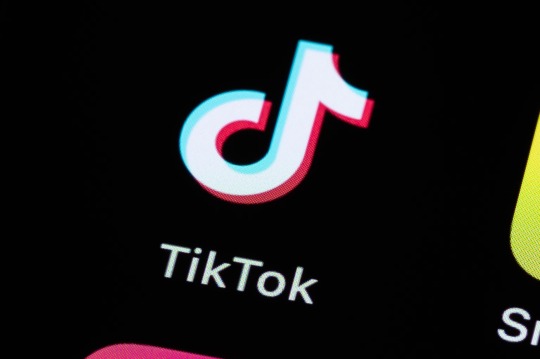
TikTok can be seen on the display of a smartphone. Picture Alliance/DPA via Getty Images
The social media giant says they are becoming the first video-sharing platform to implement Content Credentials technology -- an open technical standard providing publishers, creators, and consumers the ability to trace the origin of different types of media.
"This is like a nutrition label for content. It tells you what happened in the image, where it was taken, who made it, and the edits that were made along the way," explained Adobe's Chief Trust officer Dana Rao during an interview with ABC News earlier this year.
Adobe is one of the founding members of the Coalition for Content Provenance and Authenticity, a coalition of companies working together to push forward the adoption of this new digital standard.

TikTok increases transparency on AI. Adobe/TikTok
And Content Credentials (digital nutrition labels) are becoming more widely used as a standard to certify digital content.
Earlier this year, OpenAI announced that they would be adding this technology to all images created and edited by DALL.E 3, their latest image model. OpenAI also said it plans to integrate Content Credentials for its video-generational Model, Sora, once it is launched more broadly.
Other products with generative AI capabilities like Adobe Firefly, Photoshop, Express and Microsoft Copilot are among others who are already using the technology to embed metadata into visual content created using their platforms.
"Parts of the picture are falling into place," remarked Sam Gregory, executive director of Witness and expert on deepfakes. "It's essential that specific companies make it as easy as possible to know when content was created with their tools by providing tool-specific classifiers."

TikTok increases transparency on AI. Adobe/TikTok
TikTok said the rollout of this new label starts today and will apply to all users globally in the coming weeks. Over the coming months, TikTok will also start attaching Content Credentials to content, which will remain on the content when downloaded allowing other platforms to read the metadata.
With the United States presidential election around the corner and elections stacked across the world, demands to detect AI-generated content online have been growing more intense.
"Neither is a silver bullet, not now or when they are fully utilized and provided - they are a form of harm reduction that makes it easier to discern when and how AI was used," explained Gregory. "Malicious and deceptive creators and distributors will still find a way around them, but most of us will be happy to use them if they don't compromise our privacy or our ability to create."
Rao believes that we will move toward an online world where content that carries these digital nutrition labels might be more trustworthy or more valuable than those that do not.
"The real value is going to be in authenticity," emphasized Rao. "The creators want to have an authentic communication with their viewers, and so this content credential allows creators to establish the level of authenticity that they want with their audience."
0 notes
Text


"In a grand procession last week, Sinai Militia Leader Ibrahim al-Organi arrived at a ceremony to inaugurate the Arab Tribes Union, a new Paramilitary entity that brings together five tribal groups from across Egypt.
The formation of this alliance comes at a critical time and place, as Israel this week launched a long-threatened ground offensive against the Palestinian city of Rafah, just a short distance from where the Egyptian ceremony was held. Around 1.4 million displaced Palestinians have been sheltering in Rafah since Israel launched its war on Gaza last October.
Early on, Egypt started taking precautions for this scenario, overlooking many humanitarian details. It reinforced the fences and barriers along its border, tightened border security, and mobilised support and funding for alternative camps within Gaza itself.
The last thing the Egyptian regime wants is an image of an Egyptian soldier firing at displaced Palestinians.
Through the newly minted Arab Tribes Union, the regime might have found its only option for handling this situation, while avoiding the direct involvement of state soldiers.

A third mass grave has been uncovered at al-Shifa hospital in Gaza City. Palestinian officials say they've exhumed 49 bodies, and the recovery process is still underway.
Organi is a prime choice to lead this task after his previous successes in organising the Union of Sinai Tribes, which worked alongside the Egyptian army to fight an Islamic State affiliate, and in running companies that manage the movement of people and goods between Gaza and Egypt.
But Organi's companies have also faced allegations of exploitative behaviour, including charging millions of dollars from Palestinian refugees fleeing war.
And there are significant risks that under difficult humanitarian conditions, his forces could become involved in smuggling operations, financial extortion, or other types of corruption - not to mention the inherent dangers of forming armed militias, which can prove disastrous to the security and stability of states"
— ✍️ Ahmed Abdeen
#Middle East Eye 👁️#News 🗞️#Rafah | Gaza | Forever Palestine 🇵🇸#Egypt 🇪🇬#Sinai Militia Leader | Ibrahim al-Organi#Arab Tribes Union#Paramilitary#Al-Jazeera
0 notes
Text
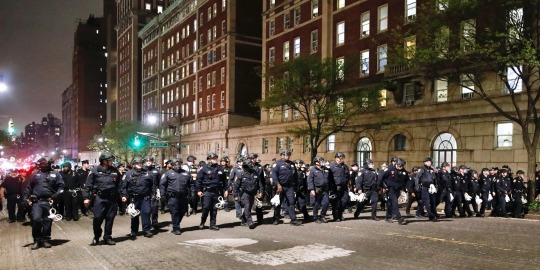
NYPD officers in riot gear march onto Columbia’s campus on April 30, 2024, in NYC. Photo: Kena Betancur/AFP via Getty Images
How Much Money Did The NYPD Waste Quashing Student Protests? We Tallied It Up.
The last big protests cost $150 million in NYPD overtime — with tens of millions more in lawsuit settlements.
— Bryce Covert | May 7 2024
IN THE EARLY hours of April 30, Columbia University President Minouche Shafik announced that negotiations with student protesters had failed. She ordered the students, who were demanding that the school divest from Israel, to disband their encampments and end their protests.
Instead, students occupied Hamilton Hall. They renamed the building — which has a long history of occupations — Hind’s Hall in honor of Hind Rajab, a 6-year-old Palestinian girl who was killed in the Gaza Strip by Israeli forces after calling for help in January.
“Every dollar that we spend on policing, especially policing that is suppressing our constitutional rights in a democracy, is an affront.”
That evening, at Shafik’s request, the New York City Police Department stormed the campus for the second time in two weeks. Hundreds of officers in riot gear showed up around 8 p.m., violently mass arresting students, and stayed until at least midnight, when the university said the area had been cleared.
Mayor Eric Adams has called for Columbia to foot some of the bill, but New York City residents are, for now, the ones paying for that violent evening. Based on estimates of the size of the police force and the cost per officer, New York spent at least $200,000 on overtime alone for the four-hour raid to clear Hamilton Hall, according to an analysis by The Intercept.
“Every dollar that we spend on policing, especially policing that is suppressing our constitutional rights in a democracy, is an affront against so many New Yorkers who are in desperate need for economic and social support,” said Jawanza Williams, director of organizing at VOCAL-NY, a community activist group. “The administration has a totally flipped, upside-down perspective when it comes to what should be a priority in the city’s spending and the city’s budget.”
Two hundred thousand dollars may not sound like much, but Williams pointed out that it could, for example, be used staff up the city’s housing discrimination office or even help families stay housed themselves.
The cost of the crackdown — part of a wider NYPD dragnet against Gaza protests — is likely to increase exponentially, especially as protests continue to grow. Large numbers of police can now be seen at most of the daily protests popping up around the city. (The NYPD did not respond to a request for comment.)
Based on past protests, the fiscal toll of the NYPD’s response could easily reach nine figures. Policing of the 2020 George Floyd protests in New York ended up costing the city nearly $150 million in overtime alone — with tens of millions, and counting, in additional settlement payouts in police abuse lawsuits.
Overtime in Overdrive
To make its estimate for the cost of the size of the police force bearing down on Columbia’s campus, The Intercept used public eyewitness accounts, publicly available photo evidence, and software tools for estimating crowd size.
Carla Mende, a graduate student who filmed what happened with a documentary team and recounted her experience to the Columbia Spectator, counted about 500 officers rushing by her. A crowd estimation tool counts nearly 200 officers in two Getty photos of helmeted police swarming the campus. At least 90 officers can be seen in footage of police climbing an armored police vehicle with a ramp on top to enter Hamilton Hall.
The cost of paying NYPD overtime, on average, is $100 per hour per officer, according to an estimate given to The Intercept by the New York City Comptroller’s Office. That means the hundreds of police who showed up at Columbia that night cost New York City hundreds of thousands of dollars in overtime.
Just going by the Mende’s estimate of 500 officers, the city spent $200,000 to clear Hamilton Hall — and that doesn’t count the officers who stayed around after Columbia declared the campus cleared, the use of military-style equipment, or other costs for the massive police mobilization.
Shafik requested that NYPD officers stay on campus from April 30 through May 17.
One student who was arrested that night told student-run radio station WKCR that police taunted the student protesters by telling them about all the overtime they were making.
Millions in Payouts
The April 30 raid on Columbia was just one of a series of recent crackdowns in which police stormed onto New York City college campuses. That same evening, according to Hell Gate, “hundreds” of officers flooded onto the City College of New York’s campus and violently disbanded its encampment. “Well over” 100 cops showed up to disband an encampment at the New School in the early hours of May 3, according to the university’s Students for Justice in Palestine chapter.
In total, the NYPD has arrested nearly 500 people at Columbia, CCNY, Fordham University, the New School, and New York University so far.
The cost of sending NYPD streaming onto college campuses will have to be absorbed by a city budget already under harsh austerity measures imposed by Adams. In September, he told all city agencies to absorb a 15 percent cut after imposing multiple rounds of cuts in 2022.
Public libraries have already eliminated Sunday service, and they’ve warned they’ll soon be forced to cut Saturday service as well. Schools that lost enrollment in the pandemic are at risk of losing funding. The city’s free preschool program for 3-year-olds is getting hollowed out. The city’s drop-off compost sites are permanently closing this month. In his April budget, Adams restored some of the slashed funding, but not all. Among the big-ticket items that the mayor reinstated funding for was money for new classes of police.
Meanwhile, the cost of the current crackdown is only going to grow. The last large-scale NYPD protest crackdown cost the city 1,000 times more than what The Intercept estimates police spent raiding colleges on April 30.
In 2020, when protests over the killings of George Floyd and Breonna Taylor erupted over the summer, huge police forces violently suppressed them. It cost the city $145.7 million in overtime, pushing total NYPD overtime costs to $721 million in 2020, up from $600 million the year before. The figure was the highest number Comptroller Brad Lander’s office documented between 2013 and 2022.
The cost of police overtime also doesn’t account for what the city will have to pay out when protesters sue over mistreatment, as they are likely to do.
The NYPD’s response to the 2020 protests resulted in a $13.7 million settlement for attacking protesters and a $7 million settlement for kettling them. Individual lawsuits added another $12 million in costs as of last summer.
Other large protests, even one-offs, have led to massive legal settlements. The police response to the 2004 Republican National Convention in Manhattan resulted in a $10.3 million settlement paid to protesters and $7.6 million spent on lawyers’ fees.
The city has paid more than $500 million in misconduct settlements over the last six years.
#The Intercept#Money 💰#Millions in Payouts#NYPD | Squashing | Students | Protests#Overtime | Overdrive
0 notes
Text
Why Americans Stopped Buying Convertibles
We’ve Traded the Open-air Dream For Climate-Controlled Isolation.
— Mark Dent | May 3, 2023

A year after I graduated college, I decided to buy a car. I’d been driving a hand-me-down Hyundai sedan, but I wanted something more reliable for the miles I racked up driving around sprawling Dallas for my job as a reporter.
At first, I narrowed my search to the Mazda 6 — at least it was more fun than a Corolla. But as I saved a few options online, hoping for something in dark green, I said to hell with all that. I could buy a convertible for roughly the same price.
A couple weeks later, a dealer showed me a 2004 Ford Mustang, white with a cream-colored canvas top. He pressed a switch on the center console, and down went the top for my test drive. I’d never ridden in a convertible before. On back roads twisting through farmland, it felt like the sky had been lowered from the atmosphere, settling just a few feet above me, close enough to touch the clouds.

An early 2000s Mustang. Bill Pugliano/Getty Images
I bought the Mustang and drove it back into the city with the top down. Over the next couple years, I drove it like that as often as I could: on cool nights with the heat turned on and windows rolled up, on a summer road trip nearly all the way through Kansas until the sunburn became unbearable.
I never got sick of the convertible. It turned everyday monotony into an adventure, replaced the rigid confinement of sedans and SUVs with freedom and openness. Who wouldn’t want one?
But the year I bought my Mustang, in 2010, US convertible sales were down to ~140K, less than half of what they’d been just a few years earlier. That was during the Great Recession, near the auto industry’s nadir. Still, the decline has continued.
According to S&P Global Mobility, new retail registrations of convertibles totaled ~70K in the 12 months between March 2023 and February 2024, comprising ~0.6% of all vehicle sales. That’s down from ~2% in the mid-2000s.
2023 sales of the Mustang convertible, which celebrates its 60th anniversary this year, were down ~87% compared to 2001. Its rival, the Chevrolet Camaro, has been discontinued.
Convertibles are an endangered species, along with the American ethos they exemplified. When Carvana polled Americans on their dream cars last year, the most coveted was an SUV. The characteristic they sought most in their dream car wasn’t emotional attachment — it was technology.
We’re losing the messy, hair-flowing-in-the-wind version of the American Dream to something climate-controlled and closed off to the world. And we might never get it back.
The Car That ‘Satisfies A Youthful Ambition’
Growing up in the ’90s, I rode countless, boring miles in the passenger seats of my dad’s Toyota Camry sedan and mom’s Plymouth Voyager minivan.
I pined for a more exotic ride just out of my reach. My next-door neighbor had an old European convertible — a midlife crisis purchase if there ever were one — and I remember the college-aged woman across the street pulling into her family’s driveway (and looking far cooler) in a Mazda Miata.
This yearning went back generations, to the time automakers, after painstakingly working to enclose early model cars with roofs, realized they could spark people’s imaginations (and extract more from their wallets) by offering a topless experience.
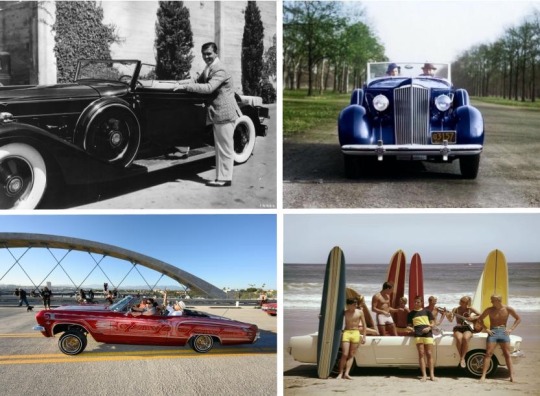
From Rhett Butler to beachgoers, everybody loved the convertible. Hulton Archive/H. Armstrong Roberts/Classicstock/Tom Kelley/Gary Leonard/Getty Images
Costing anywhere from $2K to $5K in the 1930s, roughly 2x-4x the average family income at the time, convertibles made by Duesenberg, Rolls-Royce, and Packard became status symbols for the prosperous few who could afford them.
“It is possible to follow the careers of stars through their motor cars,” noted a reporter in 1938. “When he or she first reaches the dizzy heights of movie fame, flash, gaudy cars are in order.”
Clark Gable owned a Packard convertible, and actor Wayne Morris preferred a topless ride in his Lincoln Zephyr “in any type of weather.” Marlene Dietrich was chauffeured in a tan Rolls-Royce convertible.
“No doubt,” wrote the reporter, “the gaudy car… satisfies a youthful ambition — and all of us have had it.”
The less starry got to fulfill their desires when Chevy, Lincoln, and Buick introduced roomy, space-aged convertibles in the ’50s and ’60s. My grandparents bought a 1962 seafoam-green Impala.
In 1964, Ford released the Mustang, the brainchild of famed auto developer and executive Lee Iacocca. Priced at ~$2.3K, or about one-third of the median family income, the Mustang was a magnet for middle-class Americans who wanted to inject adventure into their daily lives. It also helped bring annual convertible sales to ~500K in the mid-’60s, around 5% of total vehicle sales in America.
Safety concerns and a weak economy put a kibosh on convertible dreams in the ’70s. Cadillac claimed its ’76 Eldorado would be the last convertible ever designed, and total convertible sales fell to ~43K in 1982. But Iacocca reignited the flame with the release of the Chrysler LeBaron that year, ushering in the expanding convertible landscape I grew up with.

The Hustle
My dream car back then was a Dodge Viper, but I saw more practical convertibles everywhere in the ’90s, the peak era for manufacturers to turn the simplest of car models into adventure machines, equipped with rollover bars or fortified support pillars for safety.
The Pontiac Sunfire, Toyota Paseo, Chevrolet Cavalier, Mercury Capri, Honda Civic del Sol, Ford Probe, and Geo Metro (which could’ve lost to a riding lawn mower in a drag race) all had convertible versions.

The not-so-fast Geo Metro exemplified the wide variety of convertibles available a generation ago. Cars & Bids
Annual convertible sales Climbed to ~170K in the mid-’90s. They increased to ~315K in 2004, about 2% of the entire vehicle market, as automakers perfected the retractable hard top (and, somehow, convinced Americans to buy PT Cruiser convertibles).
Yet, as I failed to save for a Toyota Celica convertible by my 16th birthday — my realistic vision of a gaudy purchase — a tectonic market shift was underway. You could see it reflected in choices made from the Heartland to Hollywood.
After Good Will Hunting catapulted Matt Damon and Ben Affleck onto the A-list, for instance, they splurged on cars just like Gable, Morris, and other young stars before them.
Except they bought Jeep Grand Cherokees. “The really dope new truck at the time,” Affleck later explained to IMDB.
The SUV Loophole
Back in the late ’70s, the legal distinction that helped precipitate the decline of convertibles (and cars in general) seemed insignificant. A loophole the size of a needle eye.
In response to the oil crisis and a burgeoning environmental movement, federal regulations went into effect in 1978 requiring automakers’ passenger car fleets to meet a fuel standard of 18 miles per gallon. But “passenger cars” meant sedans, station wagons, coupes, and convertibles.
It didn’t apply to “light trucks” such as minivans, pickups, and SUVs, the latter two of which were mostly used by farmers, contractors, and laborers who needed the extra space for hauling material. To avoid placing an economic burden on workers, light-truck fleets were subjected to lower standards. While automakers had to shrink cars to hit the fuel standard, light trucks remained spacious.
So began an emphasis on SUVs and trucks (and minivans, at least until an association with soccer moms doomed them). SUV sales increased from ~112K in 1981 to ~800K in 1987.
Most Americans still didn’t need to haul anything, but they were hooked. In 1987, a J.D. Power and Associates survey even found SUV owners felt a sense of adventure while driving them — similar to a convertible.
For automakers, the economics checked out.
“You can sell a Cadillac for a lot more than a Chevy even though the Cadillac only costs marginally more to produce than a Chevy. The same thing goes for those truck-based SUVs because they’re sold as rugged,” says David Lucsko, an Auburn University professor who researches automotive history. “You can sell them at a premium and rake in the profits.”

The Hustle
Later, brands popularized the crossover utility vehicle, giving consumers the space of an SUV with a smoother ride. Crossovers, despite being built on the same frame as a car, are typically classified as light trucks. The takeover was complete: Light trucks outsold cars for the first time in 2002. Their sales now comprise nearly 80% of the vehicle market.
No Cars Means No Convertibles
That shift has filled the roads with increasingly large vehicles, which is hardly an ideal environment for convertibles. But Drew Dorian, managing editor for Car and Driver, says he’s doubtful safety fears have driven their decline, noting that safety-concerned families would be unlikely to buy convertibles anyway.
The Insurance Institute for Highway Safety has found that, while SUVs have lower driver fatality rates than the average vehicle, convertibles aren’t any less safe than enclosed sedans or coupes.
Speaking of sedans and coupes: Many brands don’t even make them anymore. The only Ford car that hasn’t been discontinued in North America, for instance, is the Mustang. No more Taurus or Focus or Fusion. That’s been really bad for convertibles, which are typically derived from cars.
To develop all those ’90s convertibles, automakers just tweaked the design of popular sedans at a low cost. Now, according to Tom Libby, associate director of industry analysis and loyalty solutions at S&P Global Mobility, cars aren’t popular enough to justify turning into convertibles.
“To propose a convertible now, it’s almost impossible to create a proposal that includes a volume that’s big enough to make money,” he says.
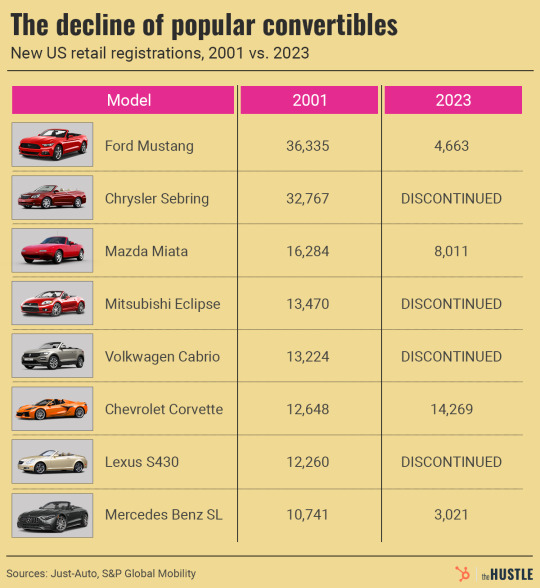
The Hustle
Money is also in short supply. Car companies are investing huge sums in the transition to electric vehicles, Libby says, and sales of EVs slowed last year, complicating the calculus of how to emphasize true EVs vs. hybrids.
Just as the purchase of a convertible requires a feeling of relative financial security and a sense of boldness, so does the act of designing one. And right now most automakers lack both.
Opting For Open Air
As with movies and clothing, trends rarely die in the auto industry. They go into hibernation until one successful experiment draws copycats and the trend becomes inescapable.
Just as the success of Iacocca’s Chrysler LeBaron led other brands to turn popular car models into convertibles in the ’80s and ’90s, Libby can imagine brands developing SUV convertibles as they seek niches for consumers demanding greater variation.
This makes sense: There’s increased time for adventure as millennials delay having kids or don’t have them at all. While summers may be excruciatingly hot, especially in the Sunbelt, the other seasons are warmer than ever. And Gen Zers crave experiences.
“The enjoyment of open air,” Libby says, “I don’t think that’s gone away.”
“But based on what happened to Nissan a few years ago,” he adds, “I don’t think [SUV convertibles are] imminent.”
He’s referring to Nissan’s crossover Murano convertible, which failed to gain traction in the 2010s. Land Rover’s Evoque was also swiftly discontinued. Americans spoke with their wallets: They didn’t want the open air.

The Land Rover Evoque. Andy Green/Land Rover via Getty Images
When I’m driving on temperate days, I rarely even see other drivers with their windows down. That might not be a coincidence. Lucsko, the car historian at Auburn, says automakers now design vehicles for consumers to seal themselves in.
“I think the car has become more and more a cocoon where we go to be isolated from the world,” he says.
Driving a convertible means being exposed to the world. It means embracing the elements and putting yourself out there, an ever-harder proposition in our increasingly curated, digital lives.
My own convertible era ended years ago. I had to ditch my Mustang for a move to hilly, snowbound central Pennsylvania. But I haven’t ditched my ambition for the open air, and I hope Americans haven’t either. Whether it’s a classic droptop or a futuristic roofless SUV, it will always feel good to say to hell with all that and buy a convertible.
#Transportation#Convertables#Open-air Dream#Climate-Controlled | Isolation#SUVs 🚙#Cars 🚙 🚗 🚘#The Hustle
0 notes
Text
Long Live Forever Palestine 🇵🇸! A Bull 🐂 Shit 💩 By The War Criminal, Demented and Genocidal Joe. Damage Has Been Done, Boak Bollocks.

“The Terrorist, Fascist, War Criminal, Apartheid, Liar, Conspirator, The Illegal Regime of the Zionist 🐖 🐷 🐖 🐗 Isra-hell” launched a major military operation in Rafah in southern Gaza even though Hamas accepted a proposed ceasefire brokered by Qatar and Egypt. The attacks come as the US revealed that it paused a bomb shipment to Israel last week over concerns about an attack on Rafah. Even though the International community and the US have warned it not to attack Rafah, Israeli tanks and armoured vehicles rolled into the crucial border crossing with Egypt on Tuesday.
#Youtube#Gaza#Rafah#Forever Palestine 🇵🇸#“The Terrorist | Fascist | War Criminal | Apartheid | Liar | Conspirator | The Illegal Regime of the Zionist 🐖 🐷 🐖 🐗 Isra-hell”
0 notes
Text
One of the Greatest Video Clip of All! Long Live Forever Palestine 🇵🇸.
Twitter has deleted the account of Saudi YouTuber Maher Musalli after he created a video about the ongoing Gaza massacre. The video is amazing, one of the greatest videos made since the crisis began. It compares Nazism and Zionism, as well as Hitler and Netanyahu, and also discusses Hollywood's role in portraying a distorted image of the Zionists. I hope Maher Musalli receives support and that the video reaches the entire world because it summarizes a lot. I pray to God that anyone who receives this video will share it widely to reach all corners of the world.
#Saudi Arabia 🇸🇦#Saudi YouTuber | Maher Musalli#The Cursed People of God | The Zionist Cunts#Video Clip of Gaza#Gaza Genocide#Nazism | Zionism | Zionist 🐖 🐷 🐖 🐗 | Hitler
1 note
·
View note
Text
“The Terrorist, Fascist, Apartheid, Liar, Conspirator, War Criminal, The Illegal Regime of The Zionist 🐖 🐷 🐖 🐗 Isra-hell's War on Gaza,” Now in Its 215th Day, Has Killed Nearly 35,000 Palestinians.
3rd Mass Grave Found at Al-Shifa Hospital
“The Terrorist, Fascist, Apartheid, Liar, Conspirator, War Criminal, The Illegal Regime of The Zionist 🐖 🐷 🐖 🐗 Isra-hell” Says Karem Abu Salem Border Crossing Reopened, But the UN Says No Aid entered
“The Terrorist, Fascist, Apartheid, Liar, Conspirator, War Criminal, The Illegal Regime of The Zionist 🐖 🐷 🐖 🐗 Isra-hell” Will Not Agree to End War and "Leave Hamas in Power" - Israeli Spokesperson

Leading Up To The Rafah Invasion:
— The U.S. government moved to ban TikTok
— Israel banned Al Jazeera
— The House legislated that antizionism is antisemitic
— Zionists want to massacre Palestinians in the dark and silence anyone who speaks up against it.
BREAKING: “The Terrorist, Fascist, Apartheid, Liar, Conspirator, War Criminal, The Illegal Regime of The Zionist 🐖 🐷 🐖 🐗 Isra-hell’s” Criminal Invasion of Rafah, The Last Place of Refuge for Palestinians in Gaza, Has Begun. 1.7 Million Civilians Trapped in Rafah Are Now Being Attacked Through Air, Land and Sea, in the Middle of The Night.

Source: CODEPINK
#The Terrorist | Fascist | Apartheid | Liar | Conspirator | War Criminal | The Illegal Regime of The Zionist 🐖 🐷 🐖 🐗 Isra-hell#War in Gaza | Genocide in Gaza#CODEPINK#Rafah#Attack Begins
0 notes

